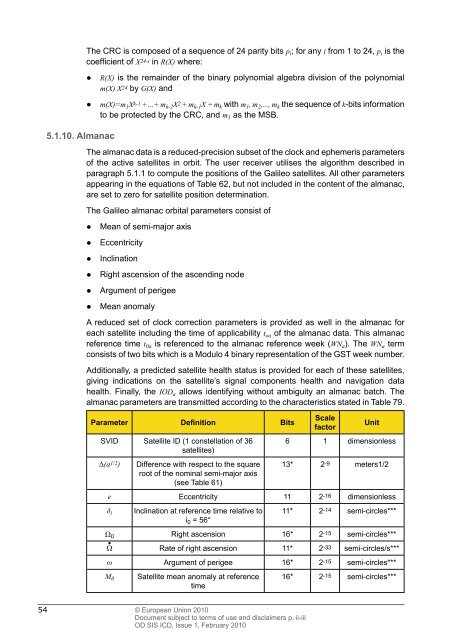(Galileo) Open Service Signal In Space Interface Control Document
(Galileo) Open Service Signal In Space Interface Control Document
(Galileo) Open Service Signal In Space Interface Control Document
You also want an ePaper? Increase the reach of your titles
YUMPU automatically turns print PDFs into web optimized ePapers that Google loves.
The CRC is composed of a sequence of 24 parity bits p i ; for any i from 1 to 24, p i is the<br />
coeffi cient of X 24-i in R(X) where:<br />
●<br />
●<br />
R(X) is the remainder of the binary polynomial algebra division of the polynomial<br />
m(X) X 24 by G(X) and<br />
m(X)=m 1 X k-1 +…+ m k-2 X 2 + m k-1 X + m k with m 1 , m 2 ,..., m k the sequence of k-bits information<br />
to be protected by the CRC, and m 1 as the MSB.<br />
5.1.10. Almanac<br />
The almanac data is a reduced-precision subset of the clock and ephemeris parameters<br />
of the active satellites in orbit. The user receiver utilises the algorithm described in<br />
paragraph 5.1.1 to compute the positions of the <strong>Galileo</strong> satellites. All other parameters<br />
appearing in the equations of Table 62, but not included in the content of the almanac,<br />
are set to zero for satellite position determination.<br />
The <strong>Galileo</strong> almanac orbital parameters consist of<br />
●<br />
●<br />
●<br />
●<br />
●<br />
●<br />
Mean of semi-major axis<br />
Eccentricity<br />
<strong>In</strong>clination<br />
Right ascension of the ascending node<br />
Argument of perigee<br />
Mean anomaly<br />
A reduced set of clock correction parameters is provided as well in the almanac for<br />
each satellite including the time of applicability t oa of the almanac data. This almanac<br />
reference time t 0a is referenced to the almanac reference week (WN a ). The WN a term<br />
consists of two bits which is a Modulo 4 binary representation of the GST week number.<br />
Additionally, a predicted satellite health status is provided for each of these satellites,<br />
giving indications on the satellite’s signal components health and navigation data<br />
health. Finally, the IOD a allows identifying without ambiguity an almanac batch. The<br />
almanac parameters are transmitted according to the characteristics stated in Table 79.<br />
Parameter Definition Bits<br />
SVID Satellite ID (1 constellation of 36<br />
satellites)<br />
Δ(a 1/2 )<br />
Difference with respect to the square<br />
root of the nominal semi-major axis<br />
(see Table 61)<br />
Scale<br />
factor<br />
Unit<br />
6 1 dimensionless<br />
13* 2 -9 meters1/2<br />
e Eccentricity 11 2 -16 dimensionless<br />
δ i<br />
<strong>In</strong>clination at reference time relative to<br />
i 0 = 56°<br />
11* 2 -14 semi-circles***<br />
Ω 0 Right ascension 16* 2 -15 semi-circles***<br />
●<br />
Ω Rate of right ascension 11* 2 -33 semi-circles/s***<br />
ω Argument of perigee 16* 2 -15 semi-circles***<br />
M 0<br />
Satellite mean anomaly at reference<br />
time<br />
16* 2 -15 semi-circles***<br />
54 © European Union 2010<br />
<strong>Document</strong> subject to terms of use and disclaimers p. ii-iii<br />
OD SIS ICD, Issue 1, February 2010
















